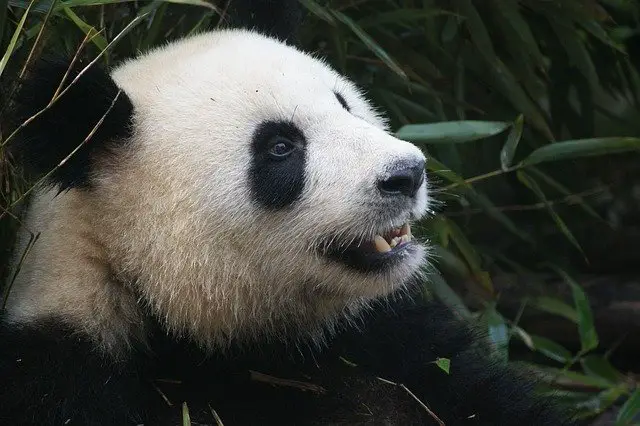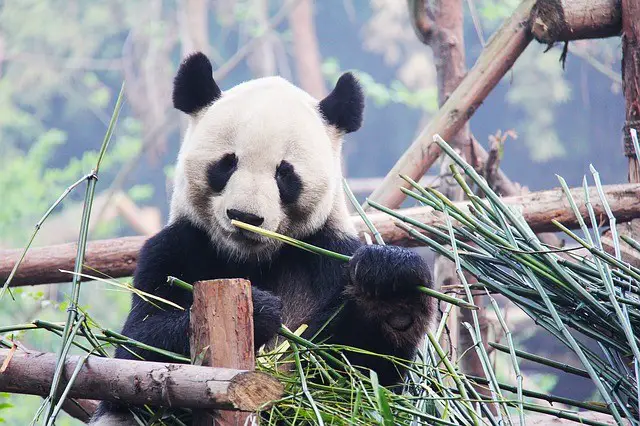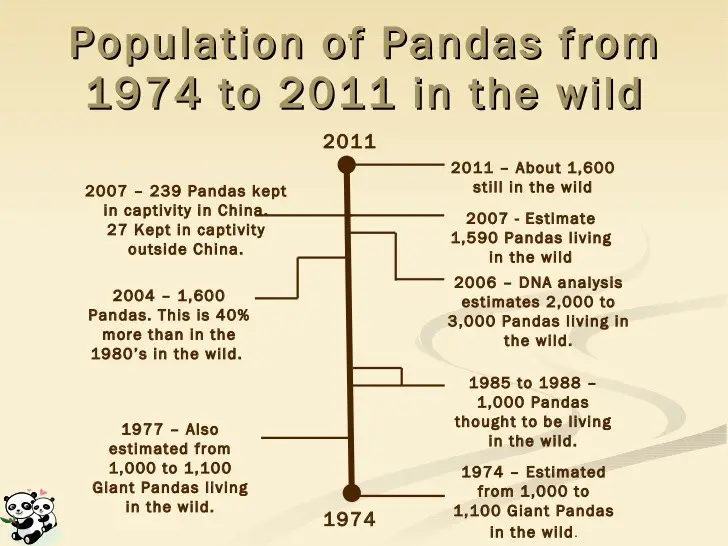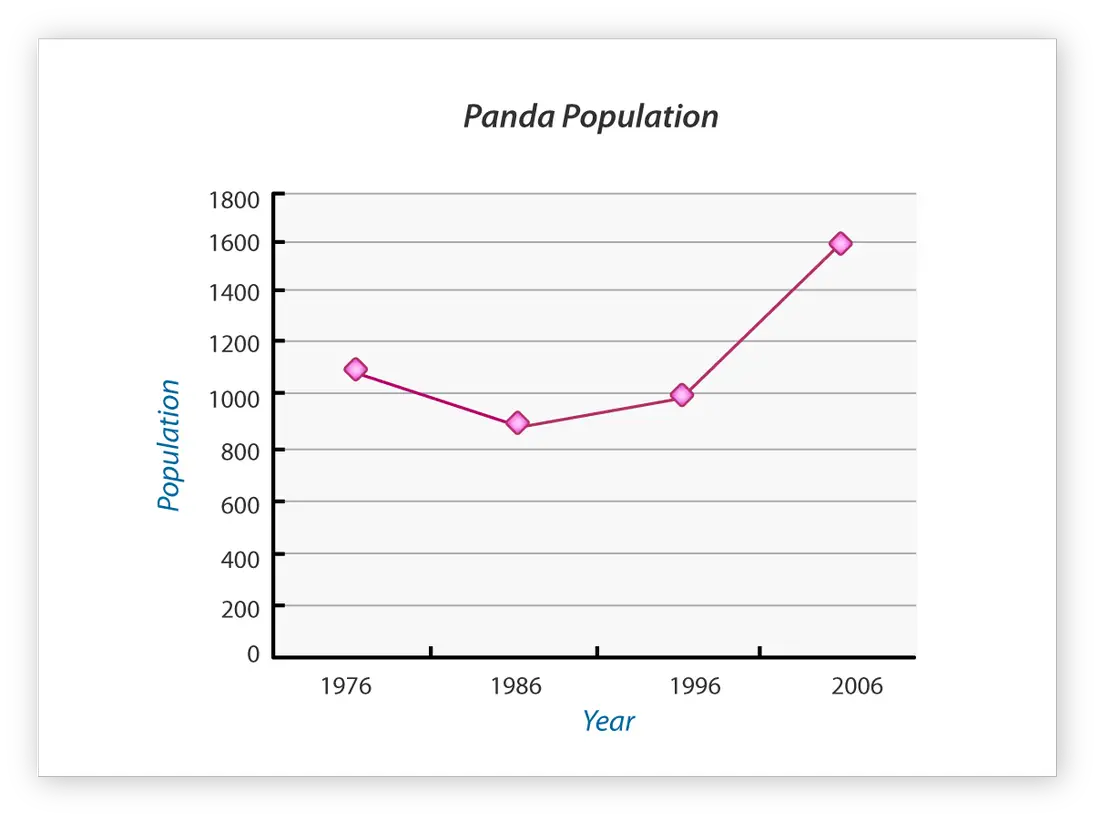Panda is an amazing animal and it has always been fascinating for kids. We have gathered some amazing Giant Panda Facts for Kids which will not only fascinate them but will also let them learn all about Pandas. Panda is also known as Giant Panda. They are members of the bear family. They are native to South Central China. We can distinguish them from bears by the large, typical black patches across their eyes, over the ears, and around their round bodies. Their black and white fur is thick and coarse. It helps them adapt to cold temperatures. They are also called bamboo bears and white bears.
Giant Panda Facts For Kids
What is a Panda?
- A panda is a huge mammal similar and closely related to the Bear.
- It is considered a true bear.
- It is easily recognizable due to the black and white patches of fur all over its body.
- The fur around their eyes, ears, and feet is black. The rest of its fur is white.
- It is native to the mountains and forests in South Central China.

What kind of animal is a Panda?
- Panda belongs to the Ursidae (Family of Bears).
- It is a wild animal.
- It is carnivorous like other bears, but over 99% of its diet is dependent on bamboo.
- A Panda is a primitive bear. It has an extended wrist bone that acts like a thumb.
- This thumb allows it to cling to bamboo trees, unlike other bears.
- They were endangered once, but now the number of pandas has increased. However, they are still vulnerable to extinction.
Panda Bear Scientific Name
- The Scientific name of Panda Bear is Ailuropoda Melanoleuca.
Scientific Classification
| Kingdom | Animalia |
| Phylum | Chordate |
| Class | Mammalia |
| Order | Carnivore |
| Suborder | Caniformia |
| Family | Ursidae |
| Genus | Ailuropoda |
| Species | Ailuropoda melanoleuca |
Are Pandas Bears?
- Yes, Pandas are bears.
- They belong to the family of bears (Ursidae).
- They are considered primitive bears.
Panda Species – How many Species of Pandas are there?
- There are two subspecies of the Giant Panda:
- Ailuropoda melanoleuca (nominate subspecies)
- A. m. qinlingensis (Qinling Panda)
- The Ailuropoda melanoleuca is the original sub-species of the Giant Panda. It is the one with black and white color patches over its body.
- The A. m. qinlingensis is the Qinling Panda.
- It is confined to the Qinling Mountains in China.
- The Qinling Panda has dark brown and light brown color patches instead of black and white patches.
- It has a smaller skull size and bigger molars.

Giant Panda Characteristics
- A male Panda is called a Boar and a female Panda is called Sows.
- A male Panda weighs about 175-250 pounds and a female Panda weighs about 150-230 pounds.
- It can grow up to a length of 1.2 to 1.9 meters.
- The shoulder height of a Panda is 0.5 to 0.8 meters.
- The average lifespan of a Panda is 20 years.
- Its paw has five fingers and a thumb.
- It has strong teeth and a powerful jaw to crush and grind bamboo.
- It has a very good memory of geographical locations.
- It has great senses of hearing and smell, but its eyesight is very poor.
- A female Giant Panda likes to stay alone and shows territorial behavior. It will aggressively defend its territory.
- A male Giant Panda isn’t territorial at all.
Why do Pandas have Black Eyes?
- Pandas have black patches around their eyes for a very important reason.
- These patches may enable the pandas to recognize other pandas.
- Pandas have a very good memory. They can memorize the black patterns around the eyes of other pandas and ultimately recognize them later.
Why Are Pandas Black and White?
- The black and white fur of the Panda acts as a camouflage in different environments.
- The white fur helps it in hiding in snowy areas.
- The black fur helps it in hiding in shadows.
- The black fur on and around its ears is a sign of aggression to ward off predators.
How Big are Giant pandas – Giant Panda Size
How Tall are Pandas
- A Panda can grow up to a length of 1.2 to 1.9 meters.
- Its shoulder height ranges from 0.5 to 0.8 meters.
- A Panda measures 3 to 4 meters when it stands up on its hind legs.
How much does a Panda Weigh – Giant Panda Weight
- A male Panda weighs about 90-135 kg and a female Panda weighs about 70-100 kg.
- A fully grown panda can weigh a maximum of up to 136 kg.
Panda Life Cycle
- The life cycle of a Giant Panda is given as:
- Newborn (0-4 months)
- Cubhood (4-24 months)
- Independence (1.5/2 years) (Female/Male)
- Maturity (4/6 years) (Female/Male)
Giant Panda Behavior
- Panda is a timid animal. It likes to keep to itself and stays away from people.
- It is a good tree-climber and is often found on bamboo trees eating bamboo.
- It doesn’t hibernate like other bears.
- It spends 12 hours a day eating bamboo and sleeps for the rest of the 12 hours.
- Male Pandas aren’t territorial, while the female Pandas are highly aggressive in defending their territory.
Life of Panda
The life of a Panda has four stages:
Newborn
• A newborn Panda is very tiny and pink in color.
• Its mother cradles it in her paw for many days without a break.
• It develops its fur within a month after birth.
• It starts crawling 3 months after birth.Cubhood
• A Panda cub starts feeding on bamboo at 6 months of age.
• It gets accustomed to eating bamboo at 9 months of age.
• It is still defenseless and has to stay with its mother at the den.
• It weighs 45 at the age of 1 year.Independence
• A cub stays with its mother for 1.5 to 2 years.
• It leaves its mother during this period if she conceives.
• It grows to full size at 4 years of age.Maturity
• A Giant Panda becomes fully mature at the age of 4 to 6 years.
• A female Panda can start breeding at 4 years of age.
• A male Panda can start breeding at 6 years of age.
• Female Pandas are fertile only for 3-4 days once a year, every spring.
• After mating, female pandas leave the males and rear their cubs alone.
• A female Panda bears one cub after every 2-3 years from an age of 4 to 16.
What do Pandas Like to do? – Giant Panda Habits
- Pandas like to spend their time alone.
- Their favorite food is bamboo.
- They like to climb trees and eat bamboo.
- They spend one half of their day eating and the other half sleeping.
Are Pandas Mean?
- Pandas are solitary and very peaceful animals.
- They like to spend their time alone. However, their defense is very strong.
- They will probably attack if provoked by anyone.
- They have very strong teeth and powerful jaws for delivering a nasty bite.
How long do Pandas Live
Panda Life Span in Wild
- The average lifespan of a Giant Panda in the wild is about 20 years.
How Long do Pandas Live in Captivity
- Pandas can live up to 30 years if they are kept under special care and diet in captivity.
What do Pandas Eat – Giant Panda Diet
- Pandas are naturally carnivorous, however, more than 99% of the diet of a Panda depends upon bamboo.
- It eats only the most nutritious parts of the bamboo.
- Sometimes they will eat other plants, rodents, and birds to keep their nutrition balanced.

How much do Pandas Eat?
- The average Giant Panda consumes as much as 9 to 14 kilograms of bamboo shoots a day.
- Giant panda drinks water at least once a day.
Panda Bear Teeth
- A Panda has very strong teeth and a powerful jawbone to help them grind and crunch bamboo.
- It uses its teeth to peel off the hard outer layer of a bamboo stalk and eat the inner tissues.
- Its teeth also act as strong defense weapons when it comes to attacking a predator.
Panda Breeding – Panda Reproduction
- The mating season is during spring, March-May.
- After mating, the female panda leaves its partner and rears the cubs on its own.
- After giving birth, the mother panda does not leave the den, not even to eat or drink. She stays in the den for several days.
- The panda cubs stay with their mother for 1.5 to 2 years before venturing off on their own.
- Giant pandas reach adulthood between the ages of four and six. Female pandas can reproduce until the age of 16.
- Pandas do not mate in captivity. Scientists use artificial insemination for their reproduction.
Baby Giant Panda – Baby Panda Facts
- A baby panda is called a cub or rookie.
- It is born pink.
- It weighs about 3-4 ounces and measures about 15 cm.
- It is born with its eyes shut. It opens its eyes in about 6-8 weeks.
- It is born without hair. When it is about 3 months old, its hair fully grows.
- It is klutzy. It often falls, trips, and rolls over while exploring its surroundings.
- A mother Panda cradles her babies in her arm for several days after birth.
- A baby panda can climb trees seven months after its birth.

How many Babies can a Panda give Birth to
- Female pandas give birth to one or two rookies (panda babies) every 2-3 years. Thus, the normal reproductive rate is one cub every 2-3 years.
Where do Giant Pandas Live – Giant Panda Habitat Facts
- Panda lives in large bamboo forests.
- Its habitat is usually humid and high mountains.
- They live in Sichuan, Shaanxi, Gansu provinces, and the mountainous eastern edge of West China.
- Sichuan province has the highest number of living pandas. Thus, Sichuan is also called the home of giant pandas.
Giant Panda Range
- Giant pandas are found in high mountains that are about 4000 to 10000 feet above sea level i.e. 1200 to 3100 meters.
- There are around 1,800 giant pandas in China that live in over an area of 20,000 square kilometers i.e. around 8,000 square miles of habitat.

Why do Pandas only live in China?
- Wild Pandas are only found in the remote mountainous regions of Central China.
- There are wet and cool bamboo forests in these areas of China that are sufficient to fulfill the Giant Panda’s all needs.
- Some Pandas are living in zoos outside of China, but they are fed manually by the zookeepers.
Panda Habitat Climate
- Pandas require bamboo trees to feed and live.
- Thus, Pandas are found in bamboo forests.
- Bamboo requires a wet and cool climate to grow.
- So, the climate of a Panda’s habitat is wet and cool.
What Animals Eat Pandas – Giant Panda Predators
- A fully grown Panda has no predators at all, however, some animals can prey on Panda cubs.
- A Panda cub is helpless when it comes to self-defense.
- Jackals, Snow Leopards, and Yellow-Throated Martens are capable of hunting panda cubs.
Giant Panda Adaptations
- The Giant Panda has several adaptations that enable it to survive in its living conditions.
- The most important adaptation is the “thumb” on its paw along with the five other fingers. This thumb lets the Panda hold the bamboo better for eating. This thumb is an extension of the wrist bone.
- The large head of the Giant Panda is also an adaptation to eating bamboo. Bamboo has a very hard outer layer which requires a powerful jaw to be chewed. Its head is very large compared to other bears and has very powerful jaw muscles.
- The large molars of the Giant Panda are another adaptation to eating bamboo. It has very large and smooth molars which are used to chew tobacco. While other bears use canines to hunt and kill.
- The Giant Panda has a different digestive system than other bears. It is a special digestive system designed specifically for digesting bamboo. The Giant Panda has developed a very strong esophagus and stomach muscles, so they don’t tear apart due to bamboo shards. Also, its intestines are shorter than other bears and colons are larger. The bamboo passes straight through the body.
Giant Panda Endangered
- Giant Pandas were endangered once but now aren’t endangered anymore.
- They are still classified as “vulnerable” on the global list of species at the risk of extinction.
- 1,864 Pandas are living in the wild in China. And 100 Pandas live around the world in zoos.
Why Pandas are Endangered? – Giant Panda Threats
- The main reason behind the endangerment of Pandas is habitat destruction.
- The forests in China are being replaced by developmental projects due to the growth of the human population.
- This is destroying the bamboo forests and pushing the Pandas into smaller and smaller habitats.
- We must stop destroying the forests, otherwise, there will be no bamboo forests left and ultimately Pandas will go extinct due to lack of food.
How many Pandas are Left – Panda Population
- 1,864 Pandas are living in the wild in China. And 100 Pandas live around the world in zoos.

How many Giant Pandas Die each Year?
- There is no information regarding the exact number of deaths per year related to Pandas.
Panda Population Graph

Giant Panda Conservation – Giant Panda Protection
- Pandas species are eight million old as compared to humans which are only two million years old, this makes them living fossils.
- Giant Pandas have been recognized as an international treasure and have been under protection since the 1950s.
- It is protected by China’s Wildlife Protection Law at national, provincial, and local levels.
- Under this law, poachers and smugglers of Giant Panda are rewarded with the death penalty or life imprisonment.
- Many natural reserves are now protecting giant pandas and The Wolong National Nature Reserve located in Wenchuan County, Sichuan Province, in China, is the most famous giant panda reserve.
- It has been recognized as China’s largest panda research institution that has been very successful in protecting pandas.

